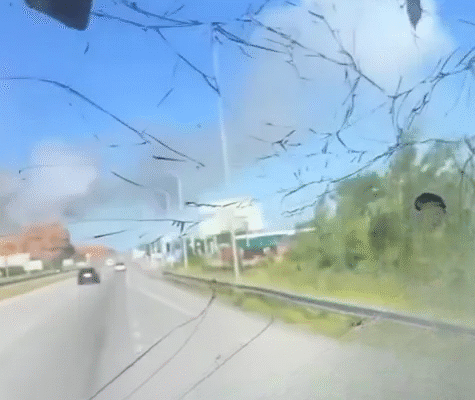On an otherwise ordinary afternoon in Zhytomyr Oblast, Ukraine, the routine rhythms of daily life were abruptly shattered. What had begun as a normal day—drivers filling their tanks, shopkeepers tending to customers, families moving about the streets—suddenly became a scene of unimaginable chaos. At approximately 4:05 p.m., a deafening explosion ripped through a local gas station, sending flames and black smoke towering into the sky. In an instant, the ordinary became catastrophic.
Residents describe the moment as surreal, a sudden rupture in the calm predictability of their town. “It felt like the world had stopped,” said one witness. “One second, everything was normal. The next, fire and smoke were everywhere.”
While the immediate aftermath saw emergency teams responding with urgency, the incident has sparked broader discussions about safety, infrastructure, and the systemic vulnerabilities facing communities across Ukraine.
The Incident: Flames and Panic
Eyewitness accounts paint a vivid picture of terror and confusion. As the blast erupted, the ground shook beneath people’s feet, vehicles were consumed by fire, and bystanders were thrown into chaos.
First responders arrived within minutes, facing a dangerous landscape: active fires, leaking fuel lines, and civilians in urgent need of medical attention. Hospitals in Zhytomyr quickly mobilized resources, issuing appeals for blood donations as the number of injured surged. Reports indicate at least 15 individuals were seriously injured, several in critical condition, while two lives were tragically lost.
The explosion occurred during peak refueling hours, highlighting the vulnerability of high-traffic fuel stations to accidents. “It was terrifying,” said one passerby. “People were running, screaming, trying to help one another. You could see the fear in everyone’s eyes.”
Emergency Response: Courage Amid Chaos
Despite the intense conditions, emergency services demonstrated remarkable resilience. Firefighters battled the inferno late into the evening, prioritizing the containment of flames to prevent further explosions. Paramedics worked tirelessly, stabilizing victims and transporting them to nearby hospitals.
Local authorities coordinated evacuation efforts, ensuring that nearby businesses and homes were cleared. Social media played a crucial role, as residents alerted one another to avoid the danger zone and shared updates about ongoing rescue operations.
These efforts, though heroic, also revealed limitations in emergency preparedness. Experts noted that some first responders lacked access to modern equipment necessary for handling large-scale industrial fires, emphasizing a recurring challenge in regional disaster management.
Investigating the Cause: Accident or Oversight?
The exact cause of the explosion remains under investigation. While Ukrainian authorities have not ruled out technical malfunction, early assessments suggest the possibility of human error, faulty equipment, or lapses in safety protocol.
Fuel stations outside major cities often operate with outdated infrastructure and insufficient oversight. Experts warn that these conditions increase the risk of accidents and highlight the urgent need for systemic reform. “This is not an isolated incident,” said one civil safety expert. “It is a symptom of broader infrastructural neglect.”
International observers have echoed these concerns, pointing to global standards for fuel station safety that are often unmet in smaller communities. Regular inspections, modern safety systems, and rigorous staff training are standard in many countries—but in Zhytomyr, such measures appear inconsistent at best.
Human Stories: Lives Disrupted
Beyond statistics, the explosion has left a profound human impact. Families mourn the loss of loved ones, while survivors confront long and painful recoveries. Children, witnessing the incident from nearby homes or schools, are grappling with trauma that will linger long after the flames have been extinguished.
Community members have come together in small acts of solidarity. Candles and flowers line the streets near the station, social media feeds overflow with messages of support, and volunteer groups have mobilized to assist displaced residents and provide aid to victims.
One volunteer, a local resident who had witnessed the explosion, described the scene: “People were crying, helping each other, looking for their neighbors. Amid the horror, you could see the heart of the community shining through.”
The Broader Context: Ukraine’s Aging Infrastructure
The Zhytomyr explosion is a stark reminder of the vulnerabilities embedded within Ukraine’s infrastructure. Across the country, many fuel stations, industrial sites, and public utilities operate with equipment that is decades old, often without consistent regulatory oversight.
Infrastructure experts argue that systemic issues—including delayed maintenance, insufficient inspections, and gaps in safety regulations—create conditions where accidents are almost inevitable. In rural and semi-urban regions, these challenges are particularly acute.
Comparisons with other countries reveal significant disparities. In nations with stringent safety enforcement, modernized facilities, and frequent emergency drills, similar incidents are far less common. Ukrainian authorities face mounting pressure to bridge this gap to prevent future tragedies.
Regulatory and Policy Challenges
The explosion has sparked debates among policymakers and civil society advocates regarding the effectiveness of current safety regulations. Critics argue that inspections are infrequent, penalties for violations are minimal, and reporting mechanisms are weak.
Calls for reform are gaining traction, with activists demanding:
-
Mandatory modernization of fuel station infrastructure
-
Regular, unannounced inspections by independent authorities
-
Comprehensive safety training for staff
-
Stronger legal accountability for negligence
Experts emphasize that without systemic change, tragedies like the Zhytomyr explosion are likely to recur. “We can’t treat these events as isolated accidents,” said one policy analyst. “They are preventable failures that reflect deeper societal challenges.”
Psychological and Social Impact
The emotional toll of the explosion extends beyond immediate victims. Mental health professionals have highlighted the psychological strain on first responders, witnesses, and the broader community. Post-traumatic stress, anxiety, and depression are potential long-term consequences for those exposed to the disaster.
Local organizations have begun offering counseling services, recognizing that recovery is not only physical but also psychological. Schools are preparing to support children affected by trauma, and community centers are hosting workshops to help residents process their experiences and rebuild a sense of security.
Lessons Learned and Moving Forward
While investigations continue, several key lessons emerge from the Zhytomyr tragedy:
-
Infrastructure Modernization is Urgent: Older fuel stations and industrial sites must be upgraded to meet current safety standards.
-
Regulatory Oversight Cannot Be Optional: Consistent inspections, clear accountability, and enforcement mechanisms are essential.
-
Community Preparedness Matters: Training citizens, improving emergency response communication, and promoting awareness can reduce casualties in future incidents.
-
Mental Health Support is Crucial: Recovery efforts must include psychological care for victims, families, and first responders.
Experts stress that these lessons are not theoretical—they represent concrete actions that can save lives and prevent future disasters.
Community Resilience: A Beacon of Hope
Amid the devastation, Zhytomyr’s residents have demonstrated resilience and solidarity. Volunteers, neighbors, and local organizations have united to provide food, shelter, and support to those affected.
Social media campaigns, local fundraising efforts, and charitable initiatives have amplified these efforts, ensuring that victims receive immediate assistance while longer-term recovery plans are developed.
Such community-driven responses underscore a crucial truth: while infrastructure may fail, human compassion remains a stabilizing force in times of crisis.
Conclusion: A Call to Action
The explosion in Zhytomyr Oblast is more than a tragic event—it is a warning. It highlights the intersection of aging infrastructure, regulatory gaps, and human vulnerability. Families mourn, survivors fight for recovery, and a community strives to reclaim normalcy from the ashes.
Yet, this tragedy also presents an opportunity. Ukraine now faces a pivotal moment: the chance to invest in safer infrastructure, enforce meaningful regulations, and cultivate a culture of vigilance that prevents future disasters.
As the smoke clears, one message resonates: ordinary days can no longer be taken for granted. The time for systemic reform, community preparedness, and national accountability is now—before another explosion turns routine life into a catastrophe.



